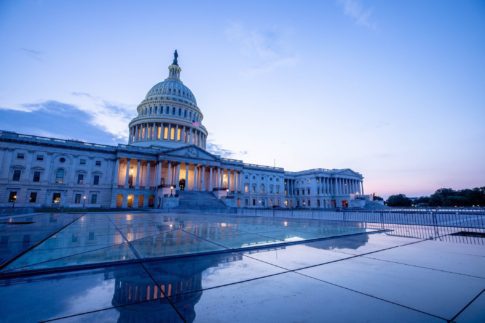The timing of changing social distancing rules and restrictions on economic activity all need to be guided by public health experts and data on the spread of the virus. Similarly, we should use data on the health of the economy to guide how much fiscal policy action is needed—not just over the next few months, but perhaps for much longer.
Using economic data-based triggers can ensure appropriate fiscal support that is aligned with economic conditions. For example, if the unemployment rate rises rapidly, it signals a recession, and certain policies should be employed. Doing so reduces the need for frequent Congressional action, which is especially valuable if political hurdles—e.g., the ability of Congress to meet in-person or political considerations during an election year—make new legislation difficult.
Data showing the early economic impact of this crisis suggests that there will likely be extensive economic damage even after social distancing policies are lifted. Much of the reduced economic activity preceded stay-at-home orders by state and local governments, prompted by individual and business decisions to avoid risk. Moreover, countries that are beginning to remove restrictions have experienced only a slow economic liftoff. This all makes it unlikely the economy will see a full rebound once social distancing policies are formally relaxed. But because there is considerable uncertainty about how the economy will perform, letting economic data on job growth and the unemployment rate guide the response is crucial.
Automatic fiscal stabilizers provide more spending and demand for the economy during downturns and less when the economy is doing well. The unemployment insurance system is a natural automatic stabilizer, providing more help to the people and places that need it when the economy slows down and job losses mount. Other safety net programs do the same. One can also design spending programs to ramp up spending when certain economic triggers are met. A Hamilton Project and Equitable Growth book, Recession Ready, proposed a set of policies that could be used in this way.
There are three main advantages to letting fiscal policy responses to a downturn be guided by automatic economic triggers: quick policy activation, faster implementation facilitated by pre-planning, and sustained policy support that lasts as long as needed.
- Timely Activation: In many cases, automatic triggers would allow swift policy responses even if the political process cannot provide timely legislation. In the current crisis, Congress acted rapidly to pass legislation with spending totaling over 10 percent of GDP—fiscal policy support has already turned on. The reason to build in economic triggers lies more in whether we need to continue policies and for how long. But, passing policies with triggers now would allow these policies to activate appropriately in the future as well, in particular if the pandemic forces a second wave of shutdowns that thrusts the economy back into a downturn.
- Implementation: A great advantage to policies that have been planned in advance is that agencies already have processes in place to allow for rapid implementation. If the IRS knew it was its responsibility to send out payments under certain circumstances, it would be ready to do so. If unemployment agencies had a responsibility to increase payments in certain circumstances, they could make preparations (especially if implementation funding is provided).
- Maintaining Support: In the current situation, the most important reason for using automatic triggers is to provide ongoing economic support for the economy if it is warranted. There is great political momentum to support the economy now, but that could fade or get lost amidst other priorities or challenges. Still, there is a very good chance that six months from now the unemployment rate will be higher than it was at any point in the Great Recession. If that is the case, we will need large and sustained support for the economy. Following the Great Recession, fiscal policy pivoted to being contractionary far faster than it normally would given the economic circumstances. Deciding now on what types of policies are appropriate under what economic conditions can make sure support is maintained. Using triggers to turn off policies can also make sure that support is turned off in a timely way. If the economy rebounds faster than expected, basing support on triggers ensures that only the support needed is provided.
There are a number of policies that would function more effectively over the next year if they had economic triggers attached. For example:
- Aid to states. Research suggests that states lose roughly $10 billion in revenue every quarter for each percentage point that the unemployment rate is elevated. This could amount to state revenue shortfalls in the hundreds of billions over the next year, which would lead states to fire thousands of workers and impair the economic recovery. After an initial tranche of funding to the states that is needed urgently, Congress could provide support based on state unemployment rates. Going forward after 2020, Congress could adjust the federal share of Medicaid spending (FMAP) according to fluctuations in state unemployment rates, automatically providing resources to states in need.
- Unemployment Insurance. The unemployment insurance (UI) system does have automatic triggers for extending benefits, but they are inadequate and need to be reformed. They turn on very slowly and have “lookback periods” which means they turn off if the unemployment rate stays elevated for a period of time. It is also important to fund these extended benefits federally to keep an extended downturn from bankrupting state UI funds. In addition, it would make sense to allow the $600 pandemic bonus payment to phase down rather than end abruptly as currently legislated. But that phase down should keep some bonus payment (e.g., $100 a week) as long as the national unemployment rate remains elevated.
- SNAP. Current legislation waives work requirements in SNAP (formerly known as the Food Stamp Program) as long as the health emergency is in place. But, these requirements should be waived as long as the economic emergency lasts as well. It is also advisable to increase SNAP benefits by 15 percent (including raising the maximum benefit) during a recession period.
- Additional checks. One important part of the CARES legislation was sending direct checks to households. If the economy stays depressed for an extended period of time, it would make sense to issue more payments to try to restart the economy. For example, if the unemployment rate is substantially elevated (5 points higher than in March) six months from now (in October), then a second round of payments could be made, followed with another round of payments a year from now if the unemployment rate is still at least 2.5 percentage points above the starting point.
- Cash support for the most vulnerable. This crisis is putting great strain on the most vulnerable. Congress could provide additional TANF funds based on the unemployment rate. In addition, it could use electronic benefit transfer (EBT) cards to provide cash to the poorest households on a monthly basis.
There are many other programs that could be improved with economic triggers. Student loan deferrals, infrastructure spending through the BUILD program, Title I funding for schools, and any number of other programs like community development grants could all spend more during the downturn before returning to normal levels. Other programs (e.g., the PPP program for small businesses) are designed more based on firms being shut down, in which case they may make more sense to extend based on stay-at-home orders as opposed to purely economic triggers.
The United States is in a public health emergency that requires substantial spending on testing, treatment, vaccines, and public health programs without regards to budgetary concerns, as stopping the virus is the most important step in restarting the economy. At the same time, there has been substantial economic damage already. The U.S. economy is in a recession, and without smart policy, could stay in one for a protracted amount of time. The Federal Reserve has taken strong actions and Congress has passed substantial fiscal support already. It will be important to let economic data guide policy going forward to make sure that support is sustained as long as it is needed.



